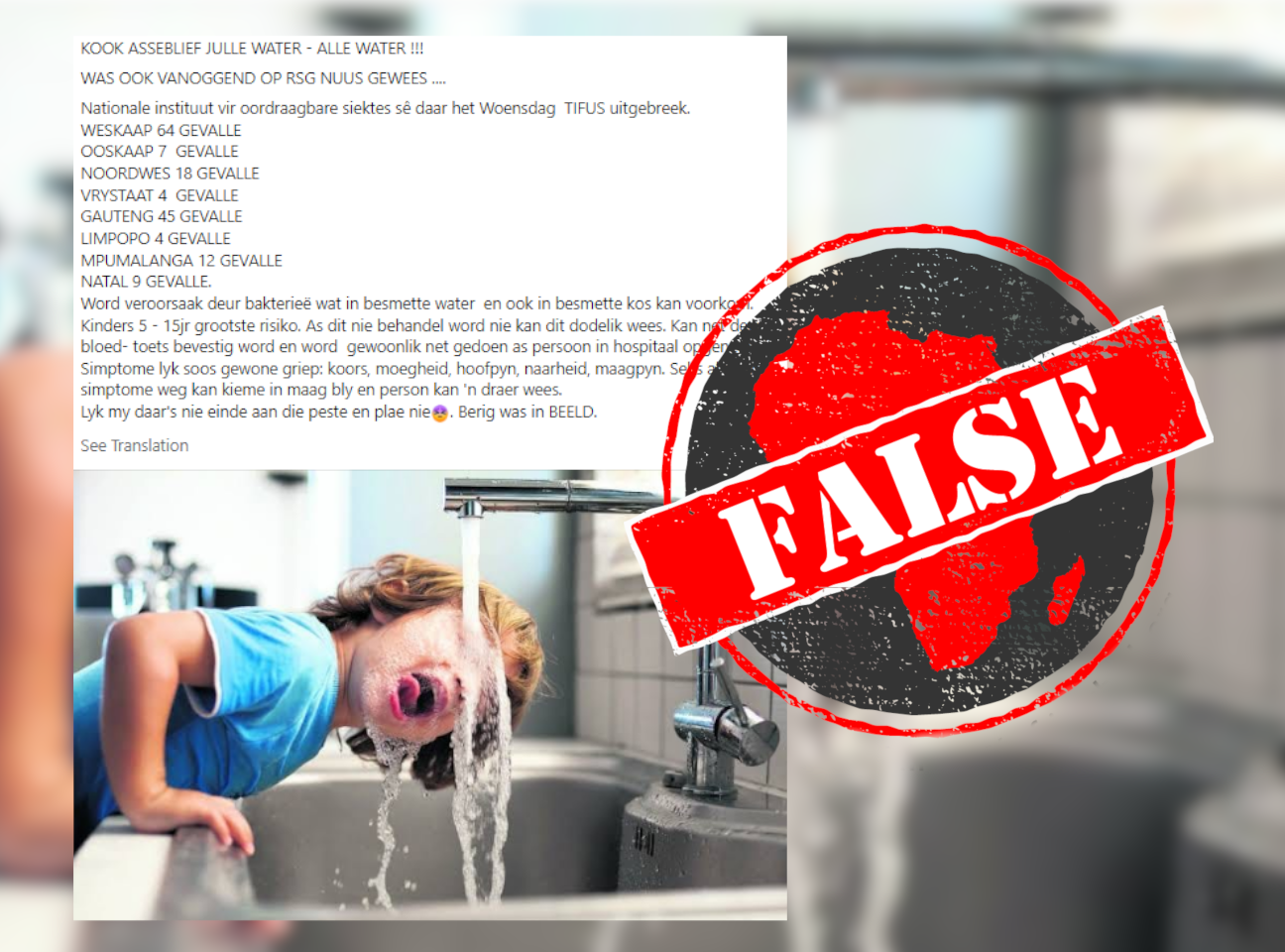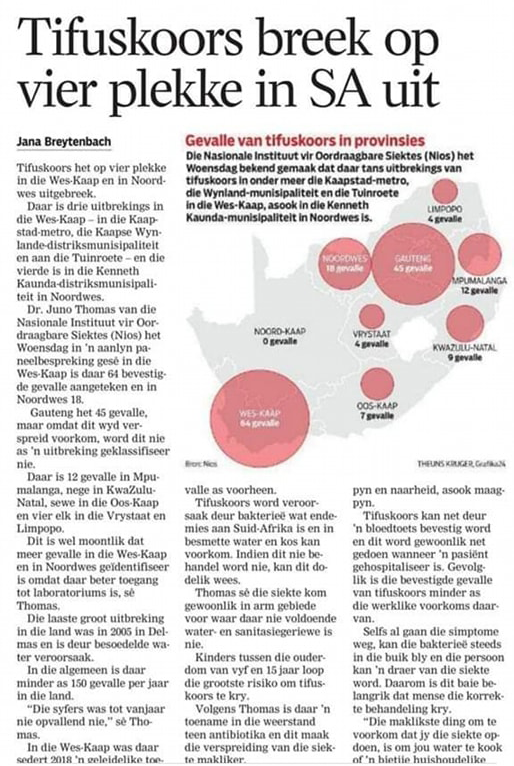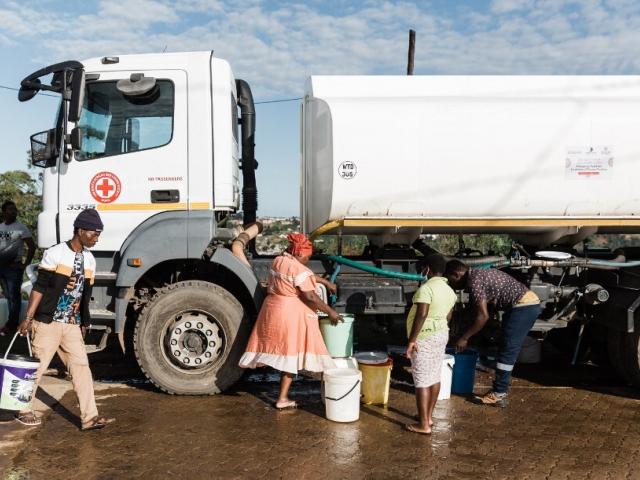IN SHORT: A message going viral in November 2022 claims that high numbers of typhoid fever cases have been reported in eight of South Africa’s nine provinces. But the message is an exact copy of another posted in February. And the original message was based on a misleading newspaper report on a two-year study.
“KOOK ASSEBLIEF JOU WATER – ALLE WATER!!!”
That’s the breathless beginning of a message that’s gone viral on Facebook and WhatsApp in South Africa since 2 November 2022.
It’s Afrikaans for: “Please boil your water – all water!!!”
The message claims that cases of “tifus” – in this case, typhoid fever – have been reported in eight of South Africa’s nine provinces.
It says the National Institute of Communicable Diseases, or NICD, announced the typhoid fever outbreak “on Wednesday”.
The message then lists the cases in each province: 64 in the Western Cape, seven in the Eastern Cape, 18 in North West, four in the Free State, 45 in Gauteng, four in Limpopo, 12 in Mpumalanga and nine in KwaZulu-Natal.
It claims the outbreak was reported by a newspaper and radio station.
The message can also be seen posted on Facebook in November 2022 here, here, here, here, here and here.
It ends with: “Lyk my daar's nie einde aan die peste en plae nie.” Translation: “Looks like there’s no end to the plagues and problems.”
But the message is incorrect. It’s a word-for-word copy of a message that first appeared on Facebook nine months ago.
And that message was based on a newspaper report that seemed alarming, but was just misleading.
Let’s discuss.

What is typhoid fever?
Typhoid fever is a dangerous disease, caused by the Salmonella typhi bacterium. Today it’s grouped with paratyphoid fever – caused by the closely related Salmonella paratyphi bacterium – under the name enteric fever. Both bacteria are related to the Salmonella bacteria that are one cause of food poisoning.
The bacteria that cause typhoid fever enter the body in contaminated water and food. The water and food is in turn contaminated by the poo of infected people.
The disease is very contagious. It spreads quickly in places where people live in poverty – most often places with dirty water that don’t have proper toilets or sewage systems that work properly.
The symptoms of typhoid fever may include a high temperature, body pains such as headache and stomachache, tiredness, coughing, not wanting to eat, wanting to throw up, constipation and diarrhoea. Some people get a rash. If left untreated, the disease can lead to death.
(It’s worth mentioning that typhoid fever is different from typhus. Typhus is caused by different bacteria and is spread through the bites of infected fleas, mites and lice.)
Message circulating since February
As several Facebook users point out, the viral November message is an exact copy of a Facebook message that first appeared in February. That means it’s nine months old. So the “tifus” outbreak it describes couldn’t be happening in November.
The original message includes a screenshot of an Afrikaans newspaper article published in February. It’s headlined: “Tifuskoors breek op vier plekke in SA uit.” This roughly translates as: “Typhoid fever breaks out in four places in South Africa.”

The article’s opening paragraphs say three of the outbreaks are in the Western Cape, and the fourth in North West.
It then gives the same typhoid fever cases as the message: 64 in the Western Cape, seven in the Eastern Cape and so on. It includes a map of the cases across South Africa. But it doesn’t say when the cases were reported.
Article gets two-year NCID study wrong
The article reports on an online panel discussion with Dr Juno Thomas of the NCID, presented on Wednesday 16 February. Thomas heads the organisation’s Centre for Enteric Diseases.
We found the panel discussion on YouTube. In her presentation, Thomas discusses a study that used genetic analysis to investigate how cases of typhoid fever across South Africa were related to each other. This identified different strains of Salmonella typhi bacteria, and traced how the infection had spread.
The study looked at the total number of cases in the country in 2020 and 2021. This is where the numbers given in the Facebook message and newspaper article come from.
There were 64 cases in the Western Cape, seven in the Eastern Cape and so on, but over two years – not in February 2022.
And the four “outbreaks” the newspaper article reports were in fact what Thomas calls “clusters of cases – cases that are due to the same genetic strain” of the typhoid bacterium. “That means they are very likely a common source of infection.”
An update on enteric fever, published on the NCID website on 18 February, describes these four clusters as “small localised outbreaks” that were “responsible for the increased case numbers” in the Western Cape and North West.
The newspaper article is misleading.
In fact, 2020 saw only the 12th-highest number of typhoid fever cases in South Africa in the 19 years since the NCID started keeping records of the disease in 2003. And 2021 only had the seventh-highest number of cases.

Typhoid fever cases in South Africa, 2003 to February 2022. (Source: NCID)
“The number of reported enteric fever cases in South Africa has declined over the last few decades, and larger outbreaks have become less common,” the NCID says.
“After the Delmas outbreak in 2005, the number of enteric fever cases in South Africa has remained stable with less than 150 cases per year (an average of 97 cases per year)."
Republish our content for free
For publishers: what to do if your post is rated false
A fact-checker has rated your Facebook or Instagram post as “false”, “altered”, “partly false” or “missing context”. This could have serious consequences. What do you do?
Click on our guide for the steps you should follow.
Publishers guideAfrica Check teams up with Facebook
Africa Check is a partner in Meta's third-party fact-checking programme to help stop the spread of false information on social media.
The content we rate as “false” will be downgraded on Facebook and Instagram. This means fewer people will see it.
You can also help identify false information on Facebook. This guide explains how.



Add new comment